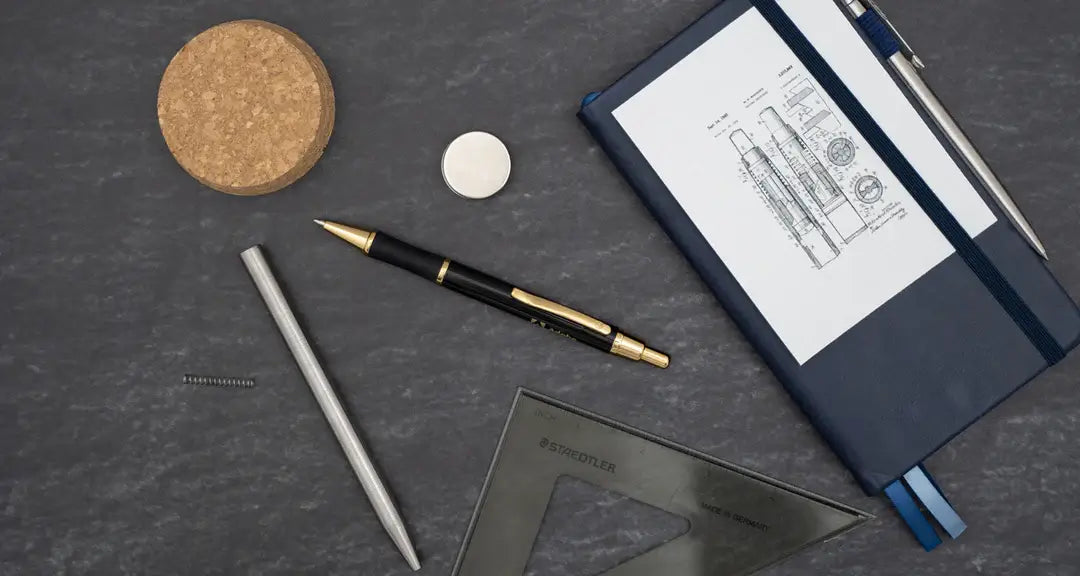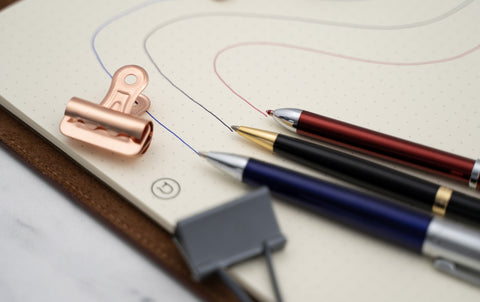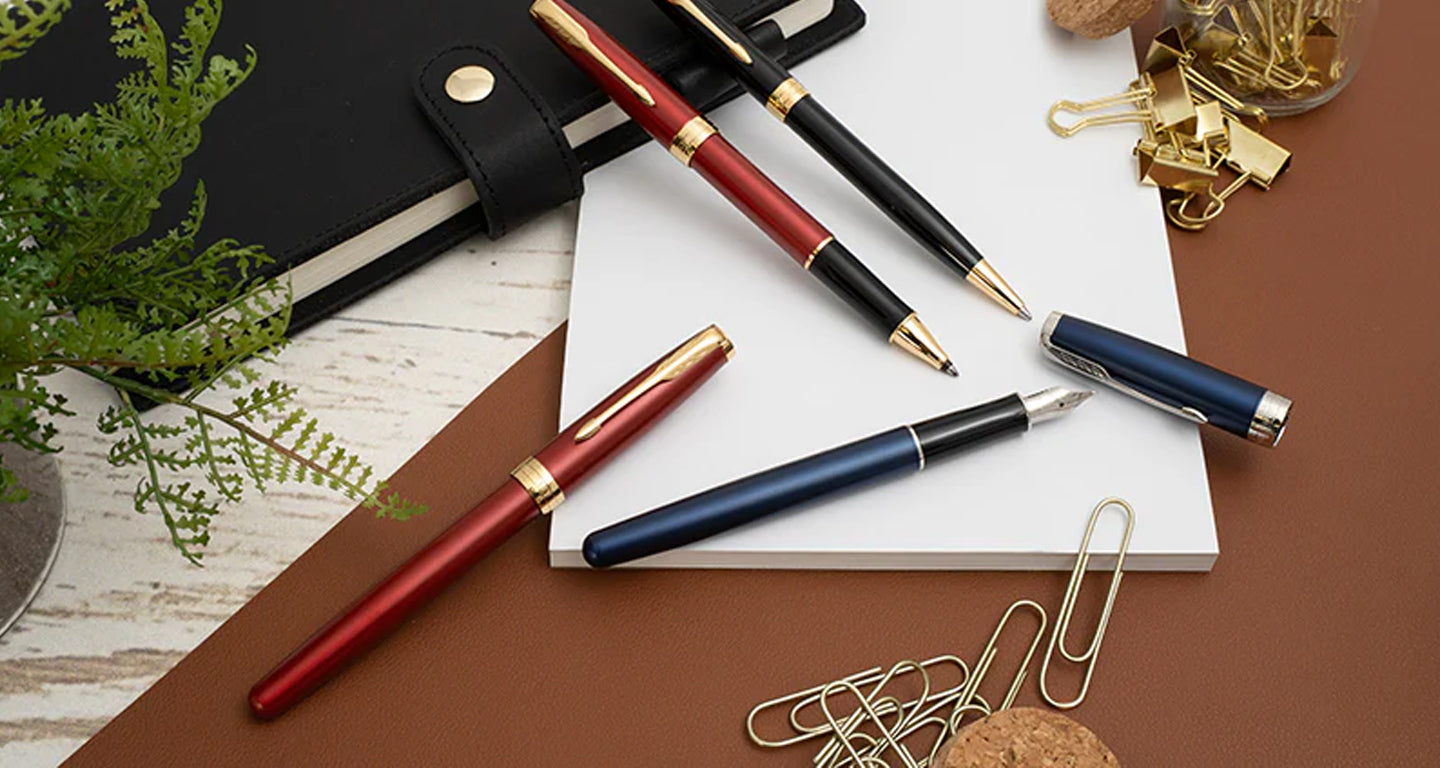
How Ballpoint Pens Are Made
If you have ever wondered what goes into making the most common writing instrument in the world, the ballpoint pen, you are not alone.
Consequently, this article will break down how manufacturers make ballpoint pens. From a basic overview, to the raw materials, and the step-by-step manufacturing process.
Firstly, let's take a look at the basics..
How are ballpoint pens made: The Basic Process
Manufacturers make ballpoint pens through a relatively simple process.
They clamp a small metal ball into a chamber, ensuring its loose enough to roll and move but not tight enough to fall out. One end opens into the ink reservoir, and the other end exposes the ball.
Next, they fill the ink reservoir with oil-based ink.
Finally, they place a barrel and grip around the ball-and-socket mechanism and ink reservoir making the ballpoint pen ready to write.
| Related Reading: Who Invented the Ballpoint Pen?: A Brief History |
Next up: what raw material is necessary for the process?
Raw Materials
The raw materials for a ballpoint pen vary greatly and depend on the material of the barrel, but manufacturers generally use the following:
- Tungsten Carbide
- Brass
- Steel
- Aluminum
- Iron
- PPC (small pellets of plastic heated and molded into the needed shapes)
Ballpoint ink is a little harder to pinpoint down to specific raw ingredients since every manufacturer has a different proprietary formula. The general components of the ink are as follows:
- Pigment or dye: carbon, eosin, crystal violet, phthalocyanine blue, etc.
- Vehicle: Kerosine, linseed oil, rosin, etc.
- Lubricant: fatty acids like oleic acid
- Thickener: Tripropylene Glycol Methyl Ether, Glycol TPM, etc.
- Surfactant: polyoxyethylene alkylamine, polyoxyethylene alkylamide, alkylalkanolamide, etc.
Common materials used in ballpoint pens
Some of the other materials that you can come across in ballpoint pens include:
- Rubber
- Gold
- Silver
- Copper
- Lacquer
- Resin
These materials are all most often used on the barrel or clip.
Luxury pens will use precious metals or rare materials. Manufacturers use different materials to make novelty pens that might include a flashlight or multifunction capabilities.
| Further Reading: What are the Best Ballpoint Pen Brands |
How Are Pens Made? A Look at the Manufacturing Process
Now let's break down the manufacturing process that goes into how pens are made.

The Ink
Each manufacturer adds raw ingredients to a batch tank and mixes them following proprietary formulas.
If some materials need to reach a certain temperature for ideal cohesion, they add the ingredients at specific times and increments.
Batch mixers may have automatic controls that release the materials at computerized intervals. Computerized batch mixers will also vary mixing times as necessary and inject the right pigments to create whatever color ink is being made.
Before finalizing, quality control tests are done on each batch of ink in the process to ensure proper ink flow and measure the effectiveness of the ink.
| Discover More: How Do Ballpoint Pens Work |
The Plastic Components
The plastic components of pens are made with PPC pellets (or sometimes powder) that are measured and poured into a hopper.
Depending on the part being made and the manufacturer, the PPC pellets either move through an extruder or into an injection molder.
Both extrusion and injection molding have a similar methodology. But one of the major differences is that one heats the PPC to the consistency of putty while the other turns the pellets into a liquid.
For an extruder: the pellets move through a large spiral screw that heats the PPC into a thick putty-like substance. Then, the high viscosity mass is pushed into a die where it cools to the desired shape, cut, and expelled.
Extruders are typically used only for simple shapes such as the barrels or refill cartridge.
However, for injection molding: the pellets are heated into a low viscosity liquid and injected into a mold where it cools and is ejected in the shape desired.
Injection molding is used in more complex shapes like the clip, cap, or pieces of a click mechanism.
The Metal Components
The metal components of a ballpoint generally consist of the ball, the tip that holds the ball, the spring and sometimes the body.
The balls of the pen are tungsten carbide balls that are purchased already made by the manufacturer.
An aside: the tungsten carbide ball is not actually a smooth round ball. The surface of the ball contains numerous divots and the ball itself is sometimes hollow, all so that the ball holds onto the ink better as it transfers it from the ink reservoir to the writing surface.
As for the rest of the metal components, the casting of the metal pieces is not unlike the extruding process for the plastic parts.
Small discs of metal (often brass, steel, or aluminum) are heated till they are malleable. The discs are then moved into a compression chamber corresponding to the shape desired.
A steel rod rams the metal into the chamber, thereby forcing a spring backed ejector plunger to retract and pushing the metal disc into the die cast mold.
Then, as the steel ram and the ejector plunger move back to their original positions, excess metal is removed and recycled and consequently, the die molded part is produced.
The Filling Process
Next, the ink refill barrel needs to be filled with ink.
There are two different methods for this process.
Method 1:
The plastic refill body and the metal ballpoint tip are joined. Ink is then injected into the refill through the tip.
Method 2:
Workers fill the plastic barrel with ink and join it to the metal tip. They then place the refill in a centrifuge, which spins the ink cartridge forcefully, making the ink move to the tip of the pen. Finally, they inject silicon ink into the hole to refill it.
How is a Pen made: step by step assembly
The pen is assembled once all parts have been manufactured.
Capped Ballpoint Pens
Capped ballpoints like Cristal Bic Pens are the simplest when it comes to assemble.
- Step 1: Press the ballpoints to the stamped metal tips/refill cartridge.
- Step 2: Place this inside the barrel and seal it.
- Step 3: Cap the point and add any additional seals, finishes, or decorations.
Click-Action Ballpoint Pens
- Step 1: Drop the plastic push button into the barrel, followed by the thrust device (also called the rotor).
- Step 2: Insert the ink cartridge tip side up.
- Step 3: Place a steel ring over the cartridge tip to provide resistance for the push mechanism.
- Step 4: Join the barrel-grip section to the topside of the barrel, sealing it.
- Step 5: Undertake quality control testing on the click mechanism to make sure the metal tips eject and recede properly.
Twist-Action Ballpoint Pens
Twist-action ballpoints follow a similar assembly line process to the click-action ballpoint.
The only difference in the assembly line is that they insert the thrust device into the cap, so when you twist it, the writing tip ejects.
Cost of making a ballpoint pen
In his incredibly informative article on the cost of manufacturing a ballpoint pen, Christoph Roser found pens, when bought in bulk from a manufacturer in China, available for a whopping $.035.
Roser estimates the cost of material and production at around $.0201 for the most entry level click-action ballpoint.
| Component | Weight (g) | Material | Material Cost ($) | Production Cost ($) |
|---|---|---|---|---|
| Barrel | 3.519 | Polypropylene | 0.0035 | 0.0033 |
| Rear Cap | 0.826 | Polypropylene | 0.00083 | 0.0033 |
| Spring | 0.175 | Steel | 0.00011 | (n/a) |
| Mine Assembly | 0.731 | (assembly) | n/a | 0.00047 |
| Ball | 0.0003 | Steel | 0.00000018 | 0.00064 |
| Ball Socket | 0.159 | Steel | 0.000095 | 0.0032 |
| Ink | 0.098 | Pixie Dust? | 0.00098 | n/a |
| Reservoir | 0.474 | Polypropylene? | 0.00047 | 0.0034 |
| Total | 5.2513 | 0.0051 | 0.015 |
Chart courtesy of Christoph Roser
Now for higher end luxury ballpoints, there really is no set price for expensive pens. Luxury goods, precious metals, and craftsman labor all significantly impact the cost of making luxury goods.
What Are the Different Types of Ballpoint Pens?
What makes a ballpoint pen is the writing point (the ball-and-socket). Also, the oil-based ink that dispenses fast drying, paste ink which can write on most surfaces.
However, within that category, there is a wide range of different types of ballpoint pens available by desired specifications.
By Color Ink
The most common ink colors are blue and black, but manufacturers can produce ink in any color. Some manufacturers even offer custom colors if customers buy in bulk.
By Mechanism
The main ballpoint mechanisms are:
- Capped - Remove the pen cap to write
- Click-action - Place a button in the cap or along the barrel that ejects the nib to write.
- Twist-action - Twist the pencap clockwise until it locks into place ejecting the writing point and counter-clockwise to retract the nib
By Finishes
Ballpoint pens can be found with plastic, metal, or wood finishes.
In general, people dispose plastic pens, while they can replace the ink cartridge in metal and wood-finished pens as needed.
Price point has the biggest impact on the finish of the pen. A plastic pen is often at the lowest end of the price range, sometimes costing only a few cents, while metal finished pens like gold, silver, or metal coated in high-quality lacquer can make a ballpoint pen cost hundreds of dollars.
By Multifunction
Multifunction ballpoint pens will include some other kind of tool or functionality in addition to a ballpoint pen.
This may be as simple as a ballpoint pen that alternates between different colored ballpoint inks, or it can be as complex as a ballpoint that is also a multi-tool such as a USB drive, a clock, or a pocket-knife.
By Novelty
Manufacturers make a novelty pen with some sort of fun or unique feature.

The entire pen might have the shape of a car or an animal, or the barrel of the pen might light up or glow in the dark.
A novelty pen typically has some sort of gimmick and are wood or plastic pens although you may find some luxury finishes in novelty pens.
What Did They Make a Pen Out of 1,000 Years Ago?
People made pens out of whittled reeds or swan feathers, cut into quills 1,000 years ago.
Pens couldn't hold much ink, so they cut a naturally occurring hollow tube into a point with a slit down the center to channel the ink.
Writers dipped the pen into ink repeatedly during the writing process to refill the hollow chamber.
The dip pen was eventually, though briefly, replaced with the fountain pen, but fountain pens had a short life as the most popular writing instrument due to the rise in manufacturing and the invention of ballpoint pens.
The rise of the ballpoint pen goes hand in hand with the rise of manufacturing. Interestingly, the first mass-manufactured pens that were easily accessible and cheap were BIC pens.
Now when you think of an average pen, ballpoint pens, not fountain pens or quills, come to mind.
Conclusion
Precision manufacturing equipment makes ballpoint pen manufacturing a straightforward process.
By molding and forming the right parts into the right shapes, and mixing the ink with a tried and true formula, manufacturers produce thousands of ballpoints every day that enhance the quality of writing.
What part of the manufacturing process did you find the most interesting?
Leave a comment or a question below.
And be sure to check out some of my other informative articles on ballpoint pens:
- How Do Fountain Pens Work?
- How to Remove Ballpoint Pen Ink Stains
- What Are The Best Brands of Fountain Pen?
|
Sam Di Nardo is an author for Dayspring Pens, where she has honed her expertise in ballpoint, rollerball, gel and fountain pens since joining the team in 2018. From her initial role as an Engraver to becoming the Production Manager, Sam's journey has been marked by her passion for the history, manufacturing, and the unique value of gifted writing instruments. A graduate of Regent University with a degree in English Literature and a special interest in Old Norse literature, dive deeper into Sam's world and discover why she's your trusted guide in the realm of gift pens. |
Share
1 comment
Thanks Samantha,
Amazingly informative.








